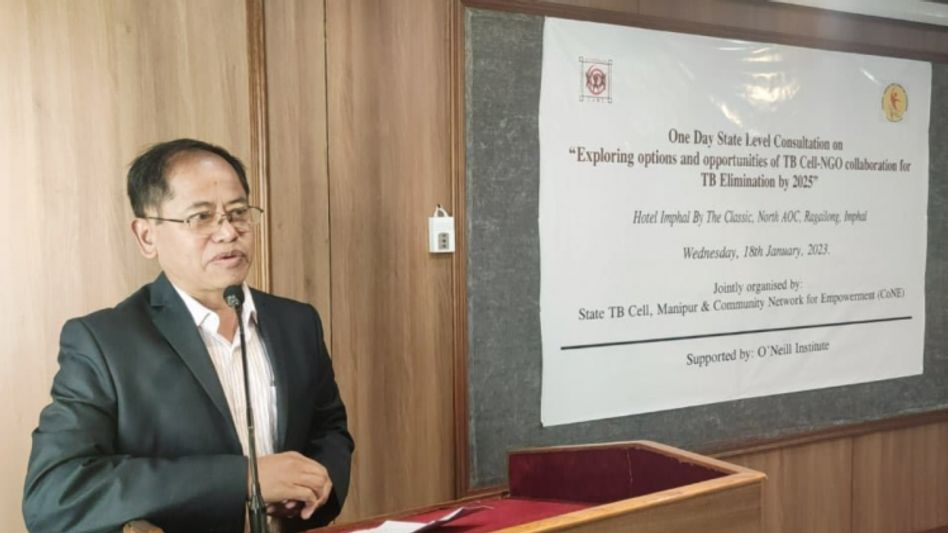Manipur: Incidence rate of tuberculosis only reduced to 142 per lakh population in 2020
The government of India had targeted to reduce the TB prevalence rate to 80 per cent by 2025 from the prevalence rate of 2015.
 State TB Officer Manipur Dr W Shashi Singh presenting his speech during consultation workshop
State TB Officer Manipur Dr W Shashi Singh presenting his speech during consultation workshopThe government of India had targeted to eliminate tuberculosis (TB) by 2025. But looking at the pace of tuberculosis treatment in the state of Manipur, many experts who are working in this field are apprehensive that whether Manipur can meet the target or not.
Manipur is amongst the state of India with a high prevalence rate of HIV and AIDS.
Tuberculosis is the commonest opportunistic infection among people living with HIV and AIDS (PLHIV). But awareness level of this disease in the state is still low. On top of that, those who have the knowledge are hesitant about its detection due to fear of stigma and discrimination.
Taking the tuberculosis treatment gap found in the state as a serious matter, Community Network for Empowerment, a community-based organisation working in the field related to HIV and AIDS organised a one-day state-level consultation on “Exploring options and opportunities of TB Cell-NGO collaboration for TB Elimination by 2025” on January 18.
It was held in association with O’Neill Institute and State TB Cell Manipur at Hotel Imphal, Imphal East.
During the consultation, programme recommendations were taken jointly with an aim to reach out to NTEP amongst the most vulnerable group, PLHIV for sure. Some of them are to carry out TB detection drives in hotspot areas mostly in de-addiction centres or rehabilitation centres, State TB Cell Manipur should conduct training programmes on NTEP and Isoniazid Preventive Therapy (IPT) amongst the service providers regularly, NGOs working for HIV and AIDS to collaborate with State TB Cell Manipur in detecting HIV status amongst people who infected with TB and state government should take initiative for implementation of 3HP treatment service in the state at earliest.
Addressing the consultation workshop, the State TB officer of Manipur, Dr W Shashi Singh said that the government of India had targeted to reduce the TB prevalence rate to 80 per cent by 2025 from the prevalence rate of 2015. As per the record, the prevalence rate of TB in India in 2015 was 244 per lakh population but in the case of Manipur, the prevalence rate in the same year is 146 per lakh population. Despite implementing various programmes, the state is unable to reduce its rate to the maximum level.
He further informed that the incidence rate of TB in Manipur was reduced to only 142 per lakh population in 2020. In order to achieve the target, the state had to decrease the prevalence rate to 33 per lakh population by 2025. To reach this goal, there is a need of strengthening the NTEP programme wherein support from NGOs is the need of the hour.
To remove stigma and discrimination which is one of the major factors to lessen TB treatment, prime minister Narendra Modi rolled out a programme called Pradhan Mantri TB Mukt Bharat Abhiyan or Nikshay Mitra on September 9. Under this programme tuberculosis patients can be adopted and cared for by an individual, elected representatives or institutions. For the state of Manipur, as many as 72 TB patients had been treated with the help of this adoption programme, he added.
President of CoNE, RK Nalinikanta said that as per the record of Manipur State AIDS Control Society (MACS), it came to know that the IPT programme is being implemented effectively. But in ground reality, many PLHIV who are infected with TB doesn’t follow the said therapy properly. The major reason behind this would be due to absence of proper counselling amongst the PLHIV.
The duration of IPT is six months. The chances of stopping the treatment without completing the course are so high. As such state government should take the initiative of switching the treatment therapy to 3HP therapy. Under 3HP, treatment last for three months and doses of medication is only once a week, he added.
He said that TB infections are prone to malnutrition. A maximum of injecting drug users and PLHIV are economically backward and are not in a position to consume good food. Therefore, from this point of view also infection of TB to them is very high. The state government shouldn’t take TB lightly because the HIV infection rate in the state is high. Mortality and morbidity of PLHIV due to TB are very high in Manipur.
TB is considered the 13th leading cause of death and the second highest disease after COVID- 19. But it seems people are hardly concerned about this infectious disease resulting in many people being unfamiliar with the TB prevention programme taken up by the central government. Just providing anti-TB medication is not sufficient to ensure that patients are cured. There is a need to look for possibilities in intervention to this issue from all sections including the NGOs to come forward and help the government in raising awareness, testing, diagnosing and treating patients effectively for TB and ultimately contributing towards achieving TB elimination by 2025, he suggested.
Copyright©2025 Living Media India Limited. For reprint rights: Syndications Today









